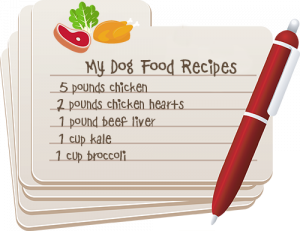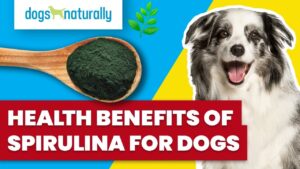Just about any veterinarian you meet will recommend glucosamine for dogs … especially if she’s getting a little stiff or achy with arthritis. Most vets have a product to sell you too … a supplement like Cosequin or Dasuquin. But there are sources of natural glucosamine for dogs too. They’re cheaper and much tastier for your dog!
What Is Glucosamine?
Glucosamine is actually a combination name made up of glutamine (an amino acid) and glucose (a sugar).Your dog’s body naturally produces its own glucosamine. It’s a substance that helps create molecules that form the cartilage of your dog’s joints.
As your dog ages, her body produces less glucosamine. So her joints can stiffen up and lose their shock-absorbing cartilage. Giving extra glucosamine for dogs can help maintain her mobility. There are three common forms of glucosamine:
- Glucosamine sulfate: this is the most common type of glucosamine used in osteoarthritis supplements … and the one that’s been most thoroughly researched. It’s extracted from the shells of shellfish. It can also be produced synthetically in a lab. The body needs sulfate to produce cartilage.
- Glucosamine hydrochloride: also known as glucosamine HCL. It also comes from shellfish shells, but doesn’t contain sulfate. It’s more concentrated than glucosamine sulfate … but some studies show it’s less effective for joint issues.
- NAG – N-Acetyl-Glucosamine: this form of glucosamine is a derivative of glucose. That’s the body’s precursor to hyaluronic acid, part of the synovial fluid that lubricates joints. NAG can be used for both joint and gastrointestinal issues. NAG comes from the outer shell of crustaceans. It’s mostly used for gut health, not for joint repair.
In joint support products, glucosamine is often combined with other ingredients like chondroitin or MSM (methylsulfonylmethane). These ingredients together can help maintain the cartilage in your dog’s joints.
What Are The Benefits Of Glucosamine For Dogs?
Glucosamine is a natural anti-inflammatory. This makes it a very popular supplement for people and pets with joint pain or stiffness. It can help improve mobility and range of motion. It can help slow the aging process in your dog’s joints.
Glucosamine is naturally produced within the joints, where it combines with collagen to produce and repair cartilage. Healthy cartilage is naturally flexible and spongy. So it acts as a shock absorber in the joints. Synovial fluid naturally lubricates the joints. Glucosamine can help maintain its viscous consistency.
With the aging process, your dog’s body makes less glucosamine. This means her cartilage deteriorates, leaving less cushioning in the joints. There’s also less lubricating synovial fluid … which is why your dog’s joints might be getting a bit “creaky” as she gets older.
So it’s a good idea to give glucosamine for dogs, especially as they age.
How Much Glycosamine Do Dogs Need?
Dogs need about 500 mg of glucosamine per day per 25 lbs of body weight.
But don’t bother adding up the grams of glucosamine your dog gets through her food. Just feed some of these foods regularly and she’ll get plenty of natural glucosamine.
For example, beef trachea is mostly cartilage, which contains about 5% glucosamine. A 1 oz piece of trachea will provide your dog with over 1400 mg of glucosamine. Or take another food, chicken feet … just one chicken foot contains about 400 mg of glucosamine.
Natural Glucosamine Sources
There’s an important benefit to giving your dog glucosamine from natural sources … and that’s bioavailability. Bioavailability refers to the amount of any nutrient (or drug) that gets digested and delivered to the cells that use it. When you give glucosamine supplements, your dog doesn’t absorb all the nutrients. In fact, a 2013 Chinese study looked at ways to improve bioavailability, noting “Glucosamine, as a dietary supplement for management of osteoarthritis, has a low and erratic oral bioavailability due to its transport-mediated absorption and presystemic loss in liver and GI tract.”
The good news is … the glucosamine your dog gets from natural supplements and food is absorbed fast. So her body can use it right away. Because it’s “just food,” her body knows what to do with it. So it takes much less natural glucosamine to be effective, compared to a synthetic supplement.
Researcher Sally Perea, in her paper titled Nutritional management of osteoarthritis published in the journal Compendium: Continuing Education for Veterinarians,stated that (in addition to omega-3 fatty acids) … “diet additives such as glucosamine, chondroitin sulfate, antioxidants, and green-lipped mussel may also have some benefit in managing osteoarthritis.”
Green Lipped Mussels
Green lipped mussels contain high levels of glucosamine. Research has proven that they reduce arthritis symptoms in dogs … and they’ve been well researched and proven to reduce arthritis symptoms in people and animals. A 2007 study at the University of Helsinki found that “dogs showed a beneficial clinical response to treating OA-induced pain and locomotion difficulties with GLM.”
Green lipped mussels are rich in glycosaminoglycans (or GAGs). Some especially important GAGs are chondroitin sulfate and hyaluronic acid. You’ll see both those in a lot of arthritis supplements. But they’re naturally found in green lipped mussels. So this means green lipped mussels can provide powerful help for your arthritic dog.
Green lipped mussels are from New Zealand so it’s hard to find them fresh. But you can buy green lipped mussel oil or powder supplements for dogs. Make sure the product is cold extracted or freeze dried as heat destroys the nutrients. And if you buy a powder, make sure it still has the oil in it. Some manufacturers strip out the oil and sell it separately. Look for a powder with at least 6% fatty acids.
Give a 50 lb dog 800 mg of green lipped mussel powder per day. If you use oil, give 50 mg per day to a 50 lb dog. Or follow the dosing instructions on the package. If you buy a product made for humans, assume it’s for a 150 lb person and adjust for your dog’s weight.
These supplements are the most effective way to give your dog green lipped mussels. But you can also buy freeze dried green lipped mussel treats and give 2 mussels for every 10 lbs of body weight per day.
Natural Eggshell Membrane (NEM®)
NEM® is the natural thin membrane that’s on the inside of an eggshell. Eggshell membrane contains naturally occurring glycosaminoglycans that help maintain cartilage and synovial fluid that protect your dog’s joints.
NEM® is an amazing supplement for dogs with arthritis. It can help reduce pain. It also improves joint function. Research in humans has shown excellent results in managing joint pain and stiffness. And now there’s research showing proven benefits in dogs too.
A 6-week trial on 51 dogs found a 23.6% improvement in pain compared to placebo, and a 26.8% quality of life improvement. The study also measured changes in serum levels of cartilage degradation biomarker CTX-II. This showed a 47.9% improvement.
Make sure the eggshell membrane you buy carries the NEM® registered trademark. Give your dog 60mg per 10 lbs of body weight a day.
Note: If you feel like a labor-intensive project, you can peel eggshell membrane off the inside of an eggshell yourself. But a supplement is a much easier way to give your dog NEM®.
What Foods Are High In Glucosamine?
These foods are delicious for your dog and are also good sources of glucosamine for dogs.
Trachea
Trachea is made up of cartilage, which is rich in glucosamine and chondroitin. Beef trachea is the easiest to find, but some raw dog food suppliers have lamb, goat or ostrich trachea.
In fact, Adequan, an injectable joint medication your vet may suggest, comes from beef trachea. It’s a semi-synthetic glycosaminoglycan that’s made by extracting glycosaminoglycans (GAGs) from bovine tracheal cartilage. So you can cut out the middle man (and the expense) and just feed your dog trachea! And because it’s food, his body will “recognize” the nutrients and absorb them easily.
Most dogs will enjoy chewing on whole raw trachea … or you can also give them dehydrated as a crunchy joint support treat.
Chicken Feet
Chicken feet are loaded with naturally occurring glucosamine for dogs. And they make a delicious crunchy snack or can be part of your dog’s meal. Some dogs like eating them still frozen. And don’t worry about the toenails – they’ll go down fine! You can also feed other poultry feet such as duck, turkey, goose or guinea fowl.
Oxtails Or Pig Tails
Tails are made up of cartilage surrounded by some meat. Cartilage is 5% glucosamine. So oxtails (beef) or pig tails are another good way to give your dog a healthy meal with plenty of glucosamine for dogs.
Beef Knuckle Bones
Beef knuckle bones have lots of cartilage … and dogs love gnawing on these big bones. A good knuckle bone can provide hours of entertainment … and it’s a valuable source of glucosamine for dogs.
Shellfish Shells
Shellfish shells contain glucosamine for dogs too. As mentioned earlier, many laboratory-made supplements contain glucosamine extracted from shellfish. So you can give your dog glucosamine by giving a natural source – shellfish shells.
If you can buy wild shrimp with the shells on, you can feed them to your dog. Or have them yourself for dinner and share them with your dog by giving her the shells and tails. You can also make any shellfish shells into a glucosamine-rich broth by simmering them in water for a few hours.
Bone Broth
Making a rich, gelatinous bone broth is another wonderful way to give your dog natural glucosamine. It’s easy to make even though it needs to spend 24 hours or so simmering on the stove (or in a slow cooker). Bone broth has countless health benefits, and it’s loaded with glucosamine and other joint-supporting nutrients.
Should I Give Glucosamine To My Dog?
What Are The Side Effects Of Glucosamine In Dogs?
There are many natural ways to give your dog glucosamine for her joints without resorting to synthetic supplements or harmful non-steroidal anti-inflamatory drugs (NSAIDs). Try a few of these foods to keep your dog mobile and pain-free!
References
- Reginster JY, Neuprez A et al. Role of glucosamine in the treatment for osteoarthritis. Rheumatol Int. 2012;32(10):2959-2967.
- Qian S, Zhang Q et al. Bioavailability enhancement of glucosamine hydrochloride by chitosan. Int J Pharm. 2013 Oct 15;455(1-2):365-73.
- Perea S. Nutritional management of osteoarthritis. Compend Contin Educ Vet. 2012 May;34(5):E4. PMID: 22581724.
- Hielm-Björkman et al. Evaluating Complementary Therapies for Canine Osteoarthritis Part I: Green-lipped Mussel (Perna canaliculus). Evid Based Complement Alternat Med. 2009;6(3):365-373.
- Ruff KJ, DeVore DP et al. Eggshell membrane: a possible new natural therapeutic for joint and connective tissue disorders. Results from two open-label human clinical studies. Clin Interv Aging. 2009;4:235-240.
- Ruff KJ, et al. Effectiveness of NEM® brand eggshell membrane in the treatment of suboptimal joint function in dogs: a multicenter, randomized, double-blind, placebo-controlled study. Vet Med (Auckl). 2016;7:113-121. Published 2016 Aug 18.
- Nicola Volpi, Patrizia Tarugi. The protective effect on Cu2+- and AAPH-mediated oxidation of human low-density lipoproteins depends on glycosaminoglycan structure. Biochimie, Volume 81, Issue 10,1999.
- Tri Dewanti Widyaningsih, Widya Dwi Rukm et al. Extraction of Glycosaminoglycans Containing Glucosamine and Chondroitin Sulfate from Chicken Claw Cartilage. Research Journal of Life Science. December 2016 Vol 03 no 03.











